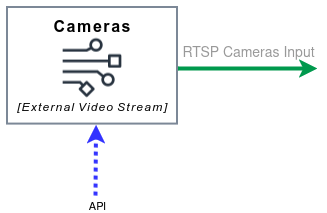RidgeRun Camera Microservice

RidgeRun's Camera Microservice captures from MIPI cameras and generates an RTSP stream for each camera using RidgeRun's RTSPSink GStreamer Element. Additionally, it removes camera distortion using RidgeRun's Cuda Undistort element.

Service Configuration
By default, the service will not start capturing from any camera; you need to give the service the camera(s) configuration through a file when starting the service or with the configuration request ((See the [service API documentation])).
In both cases, the configuration is defined in JSON format as follows:
{
"camera0": {
"index": 0,
"resolution": {
"width": 1920,
"height": 1080
},
"streaming": {
"port": 6060,
"mapping": "stream0",
"bitrate": 2000,
"uri": "rtsp://127.0.0.1:6060/stream0"
}
},
"camera1": {
"index": 2,
"resolution": {
"width": 1920,
"height": 1080
},
"streaming": {
"port": 6061,
"mapping": "stream1",
"bitrate": 2000,
"uri": "rtsp://127.0.0.1:6061/stream1"
}
}
}
This configuration allows you to include any number of cameras using this format. The identifiers camera0, camera1, and cameraN can be any name selected by the user.
- index: This value corresponds to the camera device index under /dev. For example, an index of 0 will refer to the device /dev/video0.
- resolution:
- width: Specifies the width of the video frame to capture, in pixels.
- height: Specifies the height of the video frame to capture in pixels.
- streaming:
- port: Defines the network port on which the video RTSP stream will be available.
- mapping: Indicates the network mapping for the stream.
- bitrate: Sets the encoding bitrate in bits per second (bps).
- uri: RTSP URI of the camera.
Running the Service
Using Docker
You can obtain or build a Docker image for the camera microservice; check below for the method of your preference. The image includes a base L4T image and the dependencies to run the camera microservice application. The image was developed and tested for NVIDIA JetPack 6.0. Once you get your image with either method, proceed to Launch the container
Pre-build Image
Once you obtain the camera-service Docker image, you can install it in your Jetson with the following command:
docker load < camera-service.tar.gz
Build Image
You can build the camera service image using the Dockerfile in the docker directory. First, we need to prepare the context directory for this build. You need to create a directory and include this repository and the remaining dependencies. The Dockerfile will look for all the packages in the context directory and copy them to the container.
After this, your context directory should look like this:
camera-context/ ├── camera ├── cuda-undistort ├── gst-cuda ├── gst-rtsp-sink └── rrms-utils
Then build the container image with the following command:
docker build \ --network=host \ -f Dockerfile \ -t ridgerun/camera-service:latest \ camera-context/
Change camera-context/ to your context's path and the tag to the name you want to give to the image.
Launch the container
You can ensure the image has been created successfully by running
docker images
You should get an entry showing the ridgerun/camera-service image
nvidia@ubuntu:~$ docker images REPOSITORY TAG ridgerun/camera-service latest
The container can be launched by running the following command:
docker run \ --runtime nvidia \ -it \ --network host \ --privileged \ -v /tmp/argus_socket:/tmp/argus_socket \ -v /dev/:/dev/ \ --name camera-service \ ridgerun/camera-service:latest
Here we are creating a container called camera-service that will start the camera service application (check Using Standalone Application), launching the server in 127.0.0.1 and port 5050. With this default command, you will have to perform a confirmation request in order to properly start capturing. In order to start the camera service with the right configuration, you can use the following command.
docker run \ --runtime nvidia \ -it \ --network host \ --privileged \ -v /tmp/argus_socket:/tmp/argus_socket \ -v /dev/:/dev/ \ -v <configuration file path on host>:/init_config.json \ --name camera-service \ ridgerun/camera-service:latest \ --config_file /init_config.json --host=127.0.0.1 --port=5050
Just change <configuration file path on host> with the path to your configuration file in localhost.
You can verify the container is running with:
docker ps
You should see an entry with the camera-service container:
nvidia@ubuntu:~$ docker ps CONTAINER ID IMAGE COMMAND CREATED STATUS PORTS NAMES 529b11d69113 ridgerun/camera-service "camera --config…" 24 hours ago Up 14 minutes camera-service
Using Standalone Application
You can install the camera service by running the following command from the project directory:
pip install .
Then you will have the service with the following options:
usage: camera [-h] [--config_file CONFIG_FILE] [--port PORT] [--host HOST]
options:
-h, --help show this help message and exit
--config_file CONFIG_FILE
JSON file with cameras configuration
--port PORT Port for server
--host HOST Server ip address
To start the service at address 127.0.0.1 and port 5050 with no initial configuration, just run:
camera-service
If you want to serve in a different port or address, use the --port and --host options.
If you want to start with a configuration, you can use the --config_file argument to specify the path to your configuration.



